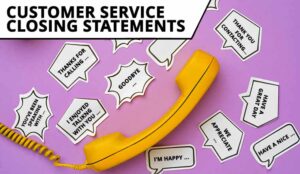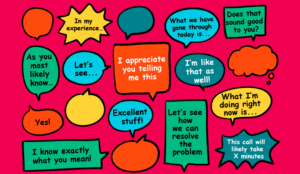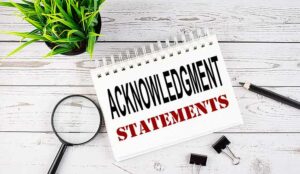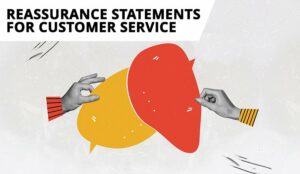An effective call-closing statement enhances customer experience, brings the interaction to a strong conclusion, and leaves the customer with a positive sentiment towards your organization.
For call centre agents, it’s a fine line between efficiency and customer satisfaction—you don’t want to delay, but you can’t rush the customer through the interaction, either.
In a people-facing role, the ability to end a conversation politely and professionally is essential. Here’s how you can use call-closing statements to transform your contact centre CX.
What Are Call-Closing Statements and Why Are They Important?
As the name suggests, agents use call-closing statements to politely signal to the customer that the customer service call is concluding.
If the primary goal of the interaction has been achieved, it’s time to outline the next steps or simply say goodbye and thank them for calling.
A strong call-closing statement provides a sense of closure, summarizes the interaction, and ends things on a positive note. This leaves customers with a feeling of satisfaction, contributing to increased loyalty, more repeat business, and better retention.
What Should You Include in a Call-Closing Statement?
The anatomy of a good call-closing statement can vary depending on the nature of the call, but, in general, it includes several standard elements. Agents should summarize the call, clarify the next steps, allow for further customer input, and end on a high.
Summary of the Call
The first step is to sum up the interaction, noting what progress has been made. Acknowledge that you’ve listened, have taken accountability for any issue, and, if necessary, have arranged for the next steps.
Example: “So, to confirm, we have updated the payment method for your account, and your monthly subscription will be charged to your new credit card from next month.”
Next Steps and Expected Timeframe
In some cases, you can reach a resolution in a single interaction, but often, further steps are required. If so, you should outline the action plan and give the customer an expected resolution timeline. Essentially, you are confirming what will happen next and when.
Example: “Your order has been confirmed, and you should expect delivery within three to five working days.”
Opportunity to Express Further Queries or Offer Additional Assistance
A call-closing statement also triggers the customer to bring up anything else they would like to discuss before the call ends.
You can be proactive and ask if there is anything you can do to prevent further issues in the future. This will serve the dual purpose of highlighting that you care and reducing the likelihood of a repeat call from the same customer.
Be careful, though; you should only ask the customer if they require further assistance if you actually managed to help them with their original issue.
Example: “Is there anything else I can help you with today?”
Courteous Final Phrase
The last step is saying thanks! Appropriately show your gratitude and thank the customer for their time, understanding, and custom. Refer to the customer by name, call back to previous information they’ve shared, and do anything you can to add a personal touch.
Example: “Thank you for calling today, Jane. I really enjoyed speaking with you. Please don’t hesitate to reach out again if there’s anything else we can help you with. Have a great day.”
Tips for an Effective Call-Closing Statement
Putting together the elements of a strong call-closing statement is one thing—effectively delivering them is another.
An agent may know what to say but struggle with exactly how to say it. Perhaps they are too eager to wrap up the call, or the message comes across as cold and scripted. Follow the tips below to avoid these pitfalls and deliver an effective call-closing statement.
Stay Authentic
If you’re insincere, customers will notice. You need to commit to interacting on a real, human level and show genuine interest in assisting the customer.
Call scripts may be helpful for training and preparing agents for common queries, but reading off them can make your agents sound rigid and unauthentic.
Keep it loose, and you can remain dynamic. Just like an actor, if you are working from a script, it must be rehearsed to sound natural.
As a call centre leader, you must strike a balance between guiding agent-customer interactions and allowing your team the freedom to go with their instincts.
Show Empathy
Empathy is essential in customer-facing roles. When you’re dealing with people all day, you need to be able to step into their shoes and see things from their perspective.
Call centre agents can use empathy to really listen and help find the right solution for the customer or resolve an impending conflict. However, it’s not enough to simply show empathy; you need to train your agents to be empathetic.
A fake display can come across as insincere and even condescending. Use empathy statements that reflect what the customer is saying, and they will feel heard. This helps establish trust and build relationships.
Personalize the Message
Nearly fifty percent of consumers say they would take their business elsewhere if a brand failed to personalize the customer experience.
Given the importance of personalization to CX, it’s essential that you incorporate it in your call-closing statements. Use the customer’s name, call back to things they’ve mentioned previously, and use contextual cues to tailor your message to the specifics of the interaction.
For example, if the customer was calling to transfer their broadband to a new house, you could wish them luck with the move. Personalization reassures the customer that you have been listening and are invested in helping them.
Offer an Apology Where Appropriate
call centre agents often have to speak to customers who are calling to complain about an issue. In that case, a part of the resolution would be an apology on behalf of your organization.
Again, balance is key. You may need to reiterate your apology a few times to satisfy the customer, but be mindful not to overdo it.
An apology on its own isn’t enough; you need to display your commitment to finding a solution and clearly explain the steps you will take to get there.
Stay True to Your Word
As always, honesty is the best policy. If you make a promise to a customer, you need to stay true to your word and deliver on it.
Remember to follow up after an outstanding issue has been resolved to confirm that the solution worked. Even if you can’t fix the problem right away, you should outline the next steps and give the customer an estimated timeline for resolving it.
For example, if a customer calls to complain about a delivery that still hasn’t arrived, you could promise to follow up in a few days to ensure their order arrived. And then do just that.
Vary the Statements
Variety is the spice of life—and call-closing statements. If you keep reeling off the same line, it will grow stale, and customers will pick up on the lack of sincerity.
Be sure to mix it up and go off-script when appropriate. Train your agents to use their instincts and pick up on contextual cues to guide them. This will allow them to personalize call-closing statements, avoiding the potential monotony of scripted lines.
Examples of Effective Call-Closing Statements in a Call Centre
While the tips above apply to all call-closing statements, the exact wording will vary depending on the scenario, the context, the customer in question, the tone of the conversation, and any other factor that impacts an agent-customer interaction.
Below, you can find examples of effective-call closing statements for call centre agents, filtered for different scenarios.
Customer Complaints and Issue Resolution
- “Thank you for bringing this to my attention. I’ll pass along your concerns to the relevant department and will be sure to follow up once the issue is resolved.”
- “Apologies once again for any inconvenience caused, John. Thank you for your call.”
- “I’m glad we were able to resolve your issue. Have a great day!”
- “If you have any further questions, please reach out to us again.”
- “Feel free to call us at any time if you require further assistance.”
- “I’m very glad I could help you today, Jane. Please call again if you need anything else in the future.”
Feedback
- “Thank you for your feedback, John. I’ll pass it along to our IT team. Have a great day!”
- “Thank you for calling today and sharing your feedback! It’s been really helpful. Please don’t hesitate to reach out again in the future if you have any additional feedback.”
General
- “Thanks for calling today, and if you have any additional questions, please don’t hesitate to reach out.”
- “Goodbye, Jane. Thank you for calling!”
- “Thanks again for calling. Is there anything else I can do for you before we end our chat?”
- “Thank you so much for calling. It was nice speaking with you.”
- “Thank you for your business. If you have any further questions or concerns, please don’t hesitate to reach out to us.”
- “We really appreciate your business.”
- “Goodbye, John. Enjoy the rest of your day!”
Final Thoughts
To deliver the best possible customer experience, you need your agents to end every interaction on a high note. An effective call-closing statement can drive productivity, improve customer sentiment, and enhance overall CX.
A strong call-closing statement is all about empathy, authenticity, and personalization—you don’t want the interaction to drag, but you can’t rush the customer off the phone, either.
This blog post has been re-published by kind permission of Scorebuddy – View the Original Article
For more information about Scorebuddy - visit the Scorebuddy Website
Call Centre Helper is not responsible for the content of these guest blog posts. The opinions expressed in this article are those of the author, and do not necessarily reflect those of Call Centre Helper.
Author: Scorebuddy
Published On: 10th Feb 2023
Read more about - Guest Blogs, Scorebuddy






 Scorebuddy is quality assurance solution for scoring customer service calls, emails and web chat. It is a dedicated, stand-alone staff scoring system based in the cloud, requiring no integration.
Scorebuddy is quality assurance solution for scoring customer service calls, emails and web chat. It is a dedicated, stand-alone staff scoring system based in the cloud, requiring no integration. 





























